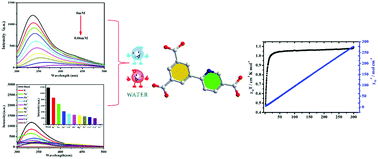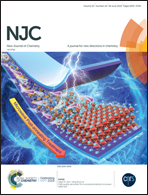Fluorescence sensing and magnetic properties of three coordination polymers based on 6-(3,5-dicarboxylphenyl)nicotinic acid and pyridine/imidazole linkers†
Abstract
Three new coordination polymers (CPs), formulated as {[Ni(HDCPN)(4,4′-bpy)(CH3CH2OH)(H2O)2]·0.5CH3CH2OH}n (1), {[Ni3(DCPN)2(4,4-bibp)4(H2O)4]·2CH3CH2OH·5H2O}n (2), and {[Cu3(DCPN)2(1,3-bimb)3]·6H2O·2DMF}n (3) (H3DCPN = 6-(3,5-dicarboxylphenyl)nicotinic acid and 1,3-bimb = 1,3-bis(imidazol-1-ylmethyl)benzene, 4,4′-bpy = 4,4′-bipyridine, 4,4′-bibp = 4,4′-bis(benzoimiazo-1-yl)biphenyl) were synthesized under hydrothermal conditions. These CPs were researched in depth by single-crystal X-ray diffraction analysis, elemental analysis (EA), IR spectroscopy, thermogravimetric analysis (TGA) and X-ray diffraction powder (PXRD) analysis. The structural analysis reveals that complex 1 exhibits a traditional 2-nodal (3,5)-{63}{69·8}-hms network, complex 2 shows a new 2D {63}{65·8}, and complex 3 exhibits a novel 3D (3,4)-c pillar-layered architecture with a point symbol of {63}2{64.8.10}3. Furthermore, magnetic studies show that complexes 1 and 2 exhibit antiferromagnetic properties. In addition, fluorescence measurements show that 3 can be applied as a probe for highly sensitive and selective detection of nitroaromatics and Fe3+ ions.



 Please wait while we load your content...
Please wait while we load your content...